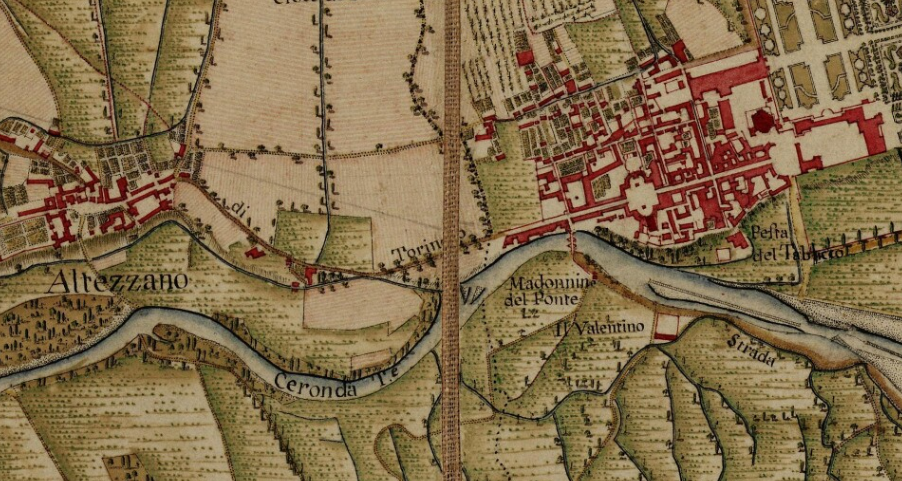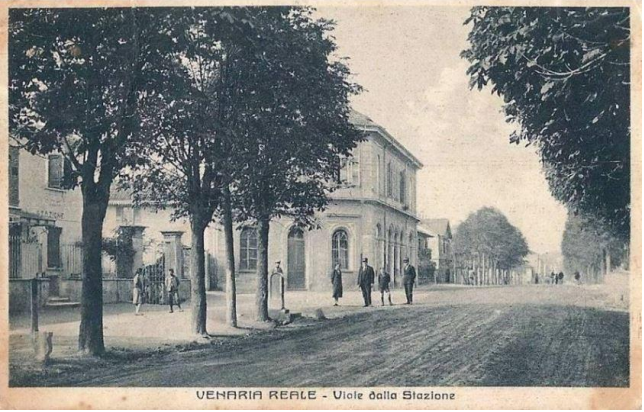Viale Roma is an ancient road that connects Venaria with Altessano and it was dedicated in 1931 to the capital. From 1887 it was known as “strada della Tranvia Altessano-Torino” (Altessano-Turin Railroad) and only around 1925 it changed its name to Viale della Stazione (Station Avenue). In the Carta delle Cacce (Charter of Hunts) of 1760 it was referred to as Strada di Torino (the Road of Turin).

Venaria Reale and Altessano, although linked by an important route, have long remained separate, subject to separate administrations, although no more than half a mile away from each other. Altessano, once Altessano Inferiore (Lower Altessano), and Venaria Reale, originally Altessano Superiore (Upper Altessano), lived different historical events that caused a clear distinction, felt to this day, in the social and cultural identity of the two urban centers.
The road axis is kind of a neutral ground where the passions and the contrasts between the inhabitants of Venaria (venariesi) and the inhabitants of Altessano (altessanesi) fade away, almost cancel out. A bridge that unites a village of ancient origins, discovered by Savoia (the Savoy) and elevated to hunting territory and an older village on the road that leads from Augusta Taurinorum (Torino – Turin) to Eporedia (Ivrea). Two different realities, not enemies but that always were kept at arm’s length.
The road is also known as “Stra dla Galopada” (Strada della Galoppata – Road of the Gallop) because in the ‘700s, the royal carriages that came from the Court of Turin to go to Venaria raced each other to who could go through it faster, not without a little apprehension among the locals.
Source: Cappelletto C. e Maschio E., Le strade di Venaria Reale percorse nel tempo. Toponomastica storica urbana, Pro Loco Altessano – Venaria Reale, 2021, pag. 89.
Ballone e Racca, All’ombra dei Savoia. Storia di Venaria Reale, Allemandi ed. , Torino, 1998, pag. 205.
The avenue

In front of the house where I was born and that I went back to inhabit after 40 years, there has always been an avenue of horse-chestnuts trees. Robust plants with a crown of thick and sturdy branches. We called it the “leja” and its history was more than a hundred years old.
When I was little, in the spring, in the month of May, the beetles fell from the leaves. On the way to school I would collect two or three of them, hide them in my pocket and then let them fly away during the lesson, causing fear in my classmates and resignation in my teachers.
That granted me entry among the class rascals.
Growing up, I would make ladders with my hands for my friends to climb up those trees and look for the nests of the goldfinches.
The first dates, the first heartbeats, with the little girls I started to show interest in, took place in the shade of these trees, which in the evening were also the favourite place for lovers.
There were also stone benches people liked to sit on during summer evenings to chat and take a breath of fresh air.
Early in the morning, before the sun came out, a concert of voices of all varieties of birds gave me the most harmonious and natural morning in the world.
With this painting always before my eyes, the years passed for me.
But one day the leaders of the City decided that all these trees were to be cut down, for they said they were old and sick and had to make room for other new ones.
Although in many years they had never planted others in place of those sick or properly pruned the healthy ones.
Unfortunately it was true.
After some time, with modern machinery and means, they began to chop the branches, cut the stems and eradicate the stumps. In a week they made clean sweep of all the trees.
The “Viale della galoppata” (Avenue of the gallop), that at the time of the Kings saw the carriages pass with the horses that ran with all speed to enter Venaria and to go to the Castle, had disappeared.
The void left in me hurt a lot, like they punched me in the stomach. My eyes kept looking for what they couldn’t find anymore. Maybe it was because I had already reached a certain age, but I suddenly felt old, disappointed, tired, and angry.
But this year, at the beginning of the spring, when I was already beginning to despair about the continuation of the work, a team of workers arrived who skillfully put back other new horse-chestnut trees but of a different quality, brought in from Tuscany.
It was strange to look at them and to see how small and weak they were, supported by wooden stakes, compared to the old, big and robust ones.
But one morning when I got up early, I crossed the road to go take a look at them and I saw that the first leaves had already come out of the buds.
It was a nice surprise, which convinced me never to despair, to trust in nature and also in men, when they work with passion and goodwill.
Felice Bertolone, historical memories of Altessano, 2000
Source: Bertolone F., Autsan mè pais, Stampato in proprio, 2021



